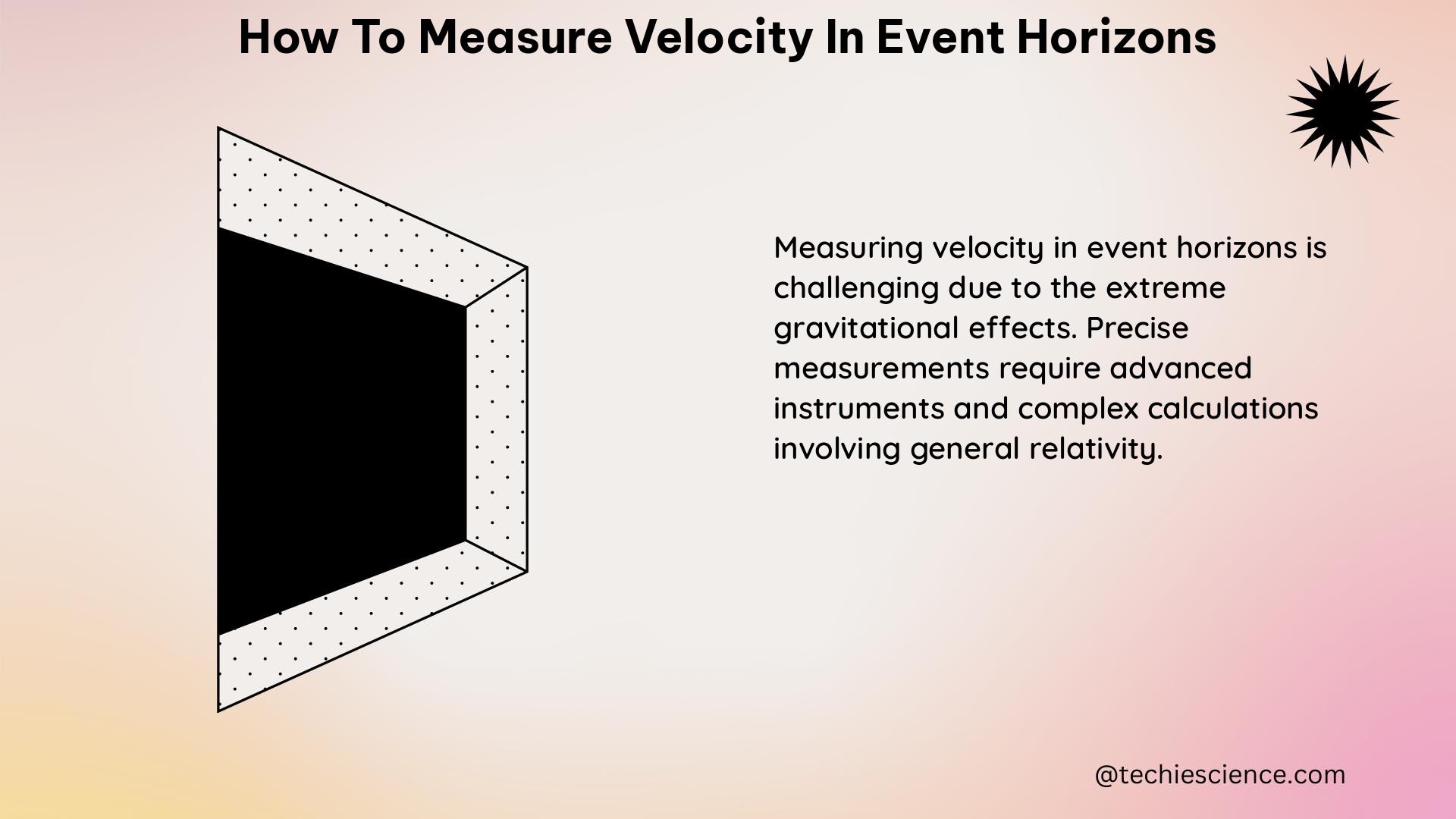Measuring the velocity within the event horizon of a black hole is an immensely challenging task due to the unique properties of these celestial objects. The event horizon is the boundary beyond which nothing, not even light, can escape the overwhelming gravitational pull of a black hole. This makes direct measurement of velocity inside the event horizon impossible. However, there are several techniques that astronomers and physicists can employ to estimate the velocity of objects approaching the event horizon or to measure the effects of the event horizon on nearby objects and radiation.
Doppler Shift Observation
One of the primary methods used to measure the velocity of an object approaching a black hole’s event horizon is by observing the Doppler shift of the electromagnetic radiation emitted by the object. The Doppler effect causes a shift in the frequency of light depending on the relative velocity between the source and the observer. By precisely measuring the frequency shift of the radiation emitted by an object as it approaches the event horizon, astronomers can estimate the object’s velocity.
The Doppler shift formula is given by:
$\frac{\Delta f}{f} = \frac{v}{c}$
Where:
– $\Delta f$ is the change in frequency of the observed radiation
– $f$ is the original frequency of the radiation
– $v$ is the velocity of the object relative to the observer
– $c$ is the speed of light
By measuring the Doppler shift and applying this formula, astronomers can calculate the velocity of the object approaching the event horizon.
Gravitational Redshift Observation

Another method to measure the effects of an event horizon is by observing the gravitational redshift of light emitted by objects near the event horizon. The gravitational redshift is a consequence of the curvature of spacetime around a massive object, such as a black hole. As light climbs out of the strong gravitational well of a black hole, it loses energy, resulting in a shift towards longer, redder wavelengths.
The gravitational redshift formula is given by:
$\frac{\Delta \lambda}{\lambda} = \frac{GM}{rc^2}$
Where:
– $\Delta \lambda$ is the change in wavelength of the observed radiation
– $\lambda$ is the original wavelength of the radiation
– $G$ is the gravitational constant
– $M$ is the mass of the black hole
– $r$ is the distance from the black hole
– $c$ is the speed of light
By measuring the redshift of light emitted by objects near the event horizon and applying this formula, astronomers can infer the strength of the gravitational field and the presence of an event horizon.
Numerical Example
Let’s consider a scenario where an object is approaching a black hole with a mass of 10 solar masses (approximately $2 \times 10^{30}$ kg) and the object is emitting radiation with a wavelength of 500 nm.
Assuming the object is 10 km away from the event horizon, and its velocity relative to the observer is 0.5c (where $c$ is the speed of light), we can calculate the Doppler shift and gravitational redshift as follows:
Doppler shift:
– $\frac{\Delta f}{f} = \frac{v}{c} = \frac{0.5c}{c} = 0.5$
– $\Delta f = 0.5f$
Gravitational redshift:
– $\frac{\Delta \lambda}{\lambda} = \frac{GM}{rc^2} = \frac{(6.67 \times 10^{-11} \text{ N m}^2/\text{kg}^2)(2 \times 10^{30} \text{ kg})}{(10 \times 10^3 \text{ m})(3 \times 10^8 \text{ m/s})^2} = 0.0667$
– $\Delta \lambda = 0.0667 \lambda = 33.35 \text{ nm}$
In this example, the Doppler shift would cause the observed frequency of the radiation to decrease by 50%, while the gravitational redshift would cause the observed wavelength to increase by approximately 33.35 nm. By measuring these shifts, astronomers can estimate the velocity of the object approaching the event horizon and the strength of the gravitational field near the black hole.
Limitations and Challenges
It’s important to note that the scenarios described above are simplified, and the actual measurements and calculations involved in determining velocity near an event horizon can be much more complex. Some of the key challenges and limitations include:
-
Observational Difficulties: Observing objects and radiation near the event horizon of a black hole is extremely challenging due to the extreme gravitational conditions and the fact that nothing can escape the black hole’s gravitational pull once it crosses the event horizon.
-
Relativistic Effects: The extreme gravitational fields near a black hole’s event horizon can introduce significant relativistic effects, such as time dilation and frame dragging, which must be taken into account when interpreting the observed data.
-
Interference and Distortion: The intense gravitational fields and the presence of accretion disks and other matter around black holes can cause significant interference and distortion of the observed radiation, making it difficult to accurately measure the Doppler shift and gravitational redshift.
-
Indirect Measurements: Since direct measurements within the event horizon are impossible, astronomers must rely on indirect methods, such as observing the effects on nearby objects and radiation, which can introduce additional uncertainties and complexities.
Despite these challenges, the study of event horizons and the development of techniques to measure their properties continue to be an active area of research in astrophysics and theoretical physics, with the potential to provide valuable insights into the nature of black holes and the fundamental laws of the universe.
References:
- What is the Event Horizon Example metrics – https://www.astro.umd.edu/~richard/ASTR480/A480_black_holes_2019_lec2.pdf
- Photon On the Event Horizon – https://www.reddit.com/r/AskPhysics/comments/162uxp0/photon_on_the_event_horizon/
- Gravitational Waves, Event Horizons and Black Hole Observation – https://www.mdpi.com/2073-8994/14/11/2276
- Doppler Effect and Redshift – https://www.physicsclassroom.com/class/waves/Lesson-3/The-Doppler-Effect
- Gravitational Redshift – https://www.physicsclassroom.com/class/circles/Lesson-4/Gravitational-Redshift

The lambdageeks.com Core SME Team is a group of experienced subject matter experts from diverse scientific and technical fields including Physics, Chemistry, Technology,Electronics & Electrical Engineering, Automotive, Mechanical Engineering. Our team collaborates to create high-quality, well-researched articles on a wide range of science and technology topics for the lambdageeks.com website.
All Our Senior SME are having more than 7 Years of experience in the respective fields . They are either Working Industry Professionals or assocaited With different Universities. Refer Our Authors Page to get to know About our Core SMEs.